#chakai
Text

Chakai Font Family by Latinotype
Download here.
Follow WE AND THE COLOR on:
Facebook I Twitter I Pinterest I YouTube I Instagram I Reddit
7 notes
·
View notes
Text
Chanyeol and Kai
#chanyeol#park chanyeol#kim jongin#kai#kim kai#loey#chakai#lucky one#i love them ❤️#exo#video#mypost05
27 notes
·
View notes
Text
Deoghar: सड़क हादसे में छोटी बहन की मौत बड़ी घायल
Deoghar: सड़क हादसे में घायल दो बहनों में से एक की मौत हो गई। मृतिका का नाम है 11 वर्षीय चांदनी कुमारी है। जो जमुई जिले के चकाई थाना क्षेत्र के धामनाडीह की रहने वाली है। पुलिस को दिए बयान में मृतका के पिता नकुल तूरी ने कहा है कि बड़ी बेटी राखी कुमारी और छोटी चांदनी कुमारी दोनों स्कूटी से चकाई बाजार गई थी।
बाजार से लौटने के क्रम में चकाई दुम्मा मोड़ के पास अपाचे सवार व्यक्ति ने तेज गति से बाइक…

View On WordPress
0 notes
Text
gee whillikers I am so bored of reading about tea
#news from the cupola#says guy who voluntarily did this to themself#but I will sit here and read about tea because it is something to do whilst I gather the confidence to go sculpt in front of the Pros#yes it is very cool and nice that Real Professional Potters are here but also I feel a desperate need to Impress Them#and the thing is that I am simply not very impressive in the pottery studio :|#this is also reminding me that I am going to be going to chakai this weekend and that I feel Very Unqualified To Do So#we have arrived at 'knows enough to be terrified of the magnitude of things they do not know' territory#and that in addition to the usual social anxiety big scary is. hm not great.
10 notes
·
View notes
Text


tinkerbell
9 notes
·
View notes
Text
In the sun-kissed landscapes of Bihar, where the rhythms of rural life intertwine with the hopes and dreams of its inhabitants, a quiet revolution is taking place. At the heart of this transformation lies the Chandan Singh Foundation in Bihar, a beacon of hope and opportunity for countless children and families across the region. Best Foundation in Bihar.
#chandan singh foundation#chandan singh foundation in bihar#chandan singh foundation in chakai#foundation in bihar#chandansinghfoundation#chandansinghfoundationinbihar#foundationinbihar
0 notes
Text
A Complete List of the Posts in the Chanoyu-to-wa Translation of the Nampō Roku, Part 1: Books One to Five.

❖ A Brief Introduction to the Nampō Roku.
https://chanoyu-to-wa.tumblr.com/post/174733308042/a-brief-introduction-to-the-namp%C5%8D-roku

◎ First Book of the Nampō Roku [一・南方錄].
This book consists of a series of introductory essays on different topics related to chanoyu. While most of the text appears to be unadulterated, occasional spurious additions -- which can be identified fairly easily because the language is anomalous -- are found in several of the passages (inserted into blank spaces in the original text). In Book One these emendations are thankfully few and far between, and have been identified in the translations.
1) The Place where the True Heart of Chanoyu may be Realized is the Informal Small Room.
http://chanoyu-to-wa.tumblr.com/post/174733550651/namp%C5%8D-roku-book-1-1-the-place-where-the-true
2) In the Roji, the Host’s Purpose is to Carry Water, and the Guests’ Purpose is to Use that Water for Washing.
http://chanoyu-to-wa.tumblr.com/post/174733810040/namp%C5%8D-roku-book-1-2-in-the-roji-the-hosts
3) The Story of Rikyū’s Geneology (and Sōkei’s Story of the Geneology of the Shū-un-an).
http://chanoyu-to-wa.tumblr.com/post/174871705633/namp%C5%8D-roku-book-1-3-the-story-of-riky%C5%ABs
4) Reciprocality Between Guest and Host.
http://chanoyu-to-wa.tumblr.com/post/174954617317/namp%C5%8D-roku-book-1-4-reciprocality-between
5) Water Sprinkled in the Roji (the Three Splashings of the Roji; and the Meaning of the Tachi-mizu).
http://chanoyu-to-wa.tumblr.com/post/174954861187/namp%C5%8D-roku-book-1-5-water-sprinkled-in-the
6) Water Sprinkled in the Roji (Footwear Worn in the Roji on Account of the Dampness).
http://chanoyu-to-wa.tumblr.com/post/175085886296/namp%C5%8D-roku-book-1-6-water-sprinkled-in-the
7) Flowers for the Small Room; and Flowers for the 4.5-mat Room.
http://chanoyu-to-wa.tumblr.com/post/175182365610/namp%C5%8D-roku-book-1-7-flowers-for-the-small
8) [Jōō’s] Kyōka Naming the Flowers Proscribed From Use in the Tearoom.
http://chanoyu-to-wa.tumblr.com/post/175182620559/namp%C5%8D-roku-book-1-8-j%C5%8D%C5%8Ds%C2%B9-ky%C5%8Dka-naming-the
9) Concerning Flowers Displayed at the Night Gathering.
http://chanoyu-to-wa.tumblr.com/post/175182890026/namp%C5%8D-roku-book-1-9-concerning-flowers
10) The Use of the Ro and the Furo – in Summer, and in the Winter.
http://chanoyu-to-wa.tumblr.com/post/175316387781/namp%C5%8D-roku-book-1-10-the-use-of-the-ro-and
11) The Importance of the Fire that is Laid in the Ro at Dawn.
http://chanoyu-to-wa.tumblr.com/post/175415244542/namp%C5%8D-roku-book-1-11-the-importance-of-the
12) Dawn Water Should Always Be Used for Making Tea.
http://chanoyu-to-wa.tumblr.com/post/175415499812/namp%C5%8D-roku-book-1-12-dawn-water-should-always
13) Lights Should be Provided for the Host and Guests at Gatherings Held when it is Dark.
http://chanoyu-to-wa.tumblr.com/post/175519037520/namp%C5%8D-roku-book-1-13-lights-should-be
14) Regarding a Gathering Held on a Snowy Day.
http://chanoyu-to-wa.tumblr.com/post/175552175318/namp%C5%8D-roku-book-1-14-regarding-a-gathering
15) A Chakai Held on a Snowy Night.
http://chanoyu-to-wa.tumblr.com/post/175585048995/namp%C5%8D-roku-book-1-15-a-chakai-held-on-a-snowy
16) Concerning the Boards that are Inserted at the Far End of the Utensil Mat.
http://chanoyu-to-wa.tumblr.com/post/175652104074/namp%C5%8D-roku-book-1-16-concerning-the-boards
17) The Utensils for the Small Room.
http://chanoyu-to-wa.tumblr.com/post/175662294463/namp%C5%8D-roku-book-1-17-the-utensils-for-the
18) Some Words of Advice to the Owner of a Meibutsu Scroll.
http://chanoyu-to-wa.tumblr.com/post/175790686461/namp%C5%8D-roku-book-1-18-some-words-of-advice-to
19) The Kakemono is the Most Important Utensil.
http://chanoyu-to-wa.tumblr.com/post/175895449453/namp%C5%8D-roku-book-1-19-the-kakemono-is-the-most
20) The Meal Served in the Small Room.
http://chanoyu-to-wa.tumblr.com/post/175899902423/namp%C5%8D-roku-book-1-20-the-meal-served-in-the
21) The Use of the Handai.
http://chanoyu-to-wa.tumblr.com/post/176047053533/namp%C5%8D-roku-book-1-21-the-use-of-the-handai%C2%B9
22) Displaying the Cha-tsubo in the Small Room.
http://chanoyu-to-wa.tumblr.com/post/176134765047/namp%C5%8D-roku-book-1-22-displaying-the-cha-tsubo
23) The Case of the Sute-tsubo [捨壺].
http://chanoyu-to-wa.tumblr.com/post/176322833528/namp%C5%8D-roku-book-1-23-the-case-of-the
24) There is no Sumi-shomō in the Case of the Furo.
http://chanoyu-to-wa.tumblr.com/post/176323194153/namp%C5%8D-roku-book-1-24-there-is-no-sumi-shom%C5%8D%C2%B9
25) Concerning the Tsurube.
http://chanoyu-to-wa.tumblr.com/post/176434558033/namp%C5%8D-roku-book-1-25-concerning-the-tsurube
26) The Way to Orient the Shin no Te-oke and the Tsurube on the Utensil Mat.
http://chanoyu-to-wa.tumblr.com/post/176532255018/namp%C5%8D-roku-book-1-26-the-way-to-orient-the
27) The Fu-ji [不時] Gathering.
http://chanoyu-to-wa.tumblr.com/post/176634502853/namp%C5%8D-roku-book-1-27-the-fu-ji-%E4%B8%8D%E6%99%82
28) The Hanaire for the Small Room.
http://chanoyu-to-wa.tumblr.com/post/176634781343/namp%C5%8D-roku-book-1-28-the-hanaire-for-the
29) The Way to Orient the Objects on the Utensil Mat.
https://chanoyu-to-wa.tumblr.com/post/176781284214/namp%C5%8D-roku-book-1-29-the-way-to-orient-the
30) How to Remove the Fukuro from a Chaire.
https://chanoyu-to-wa.tumblr.com/post/176781570586/namp%C5%8D-roku-book-1-30-how-to-remove-the
31) No-gake [野懸け] (part 1) – the Daizen-ji Mountain Chakai.
https://chanoyu-to-wa.tumblr.com/post/176889262939/namp%C5%8D-roku-book-1-31-no-gake-%E9%87%8E%E6%87%B8%E3%81%91%C2%B9-part-1
32) No-gake (part 2) – Cha Ichi-dō [茶一道], the One Path of Tea.
https://chanoyu-to-wa.tumblr.com/post/177035199937/namp%C5%8D-roku-book-1-32-no-gake-part-2-cha
33a) The Mind of Wabi-Chanoyu in Poetry (part 1): the Poem Discovered by Jōō.
https://chanoyu-to-wa.tumblr.com/post/177142532763/namp%C5%8D-roku-book-1-33a-the-mind-of
33b) The Mind of Wabi-Chanoyu in Poetry (part 2): the Poem Discovered by Rikyū.
https://chanoyu-to-wa.tumblr.com/post/177287743728/namp%C5%8D-roku-book-1-33b-the-mind-of

◎ Second Book of the Nampō Roku [二・南方錄].
The second book is a copy of Rikyū’s the official chakai [茶會], documenting, primarily, gatherings that Rikyū hosted on behalf of Hideyoshi, for his guests.
This document covers the “tea year” that ran from the Tenth Lunar Month of Tenshō 14, hei-jutsu [ 天正十四年, 丙戌], the 23rd year in the 60-year cycle (1586) -- which marks the beginning of the ro [爐] season, and was considered the beginning of the “tea year” (since that is when the tea harvested in early summer was first used) -- and the end of the Ninth Lunar Month of Tenshō 15, tei-gai [天正十五年, 丁亥], the 24th year in the 60-year cycle (1587).
Each post shows photographs of all of the utensils that were used, and also discusses the guests, and the food and other things that were served during the chakai [茶會].
Introduction) Nambō Sōkei’s the Preface to Rikyū’s Kaiki.
https://chanoyu-to-wa.tumblr.com/post/177529376574/namp%C5%8D-roku-book-2-introduction-kai-%E6%9C%83
1) (1586) Tenth Month, First Day.
http://chanoyu-to-wa.tumblr.com/post/177529839741/namp%C5%8D-roku-book-2-1-1586-tenth-month-first
2) (1586) Tenth Month, First Day, Go-atomi [御跡見].
http://chanoyu-to-wa.tumblr.com/post/177633250263/namp%C5%8D-roku-book-2-2-1586-tenth-month-first
3) (1586) Tenth Month, Third Day, Beginning at Dawn.
http://chanoyu-to-wa.tumblr.com/post/177778020094/namp%C5%8D-roku-book-2-3-1586-tenth-month-third
4) (1586) Tenth Month, Fifth Day, Evening; Fu-ji [不時].
http://chanoyu-to-wa.tumblr.com/post/177884959363/namp%C5%8D-roku-book-2-4-1586-tenth-month-fifth
4a) Appendix (the Basic Concept of Kane-wari, and Kane-wari as Jōō Applied it to the Fukuro-dana).
http://chanoyu-to-wa.tumblr.com/post/179162219058/namp%C5%8D-roku-book-2-4a-appendix-the-basic
5) (1586) Tenth Month, Eleventh Day, Morning.
http://chanoyu-to-wa.tumblr.com/post/179255261450/namp%C5%8D-roku-book-2-5-1586-tenth-month
6) (1586) Tenth Month, Twenty-ninth Day, Morning; Jōō no Ki-jitsu [紹鷗の忌日].
http://chanoyu-to-wa.tumblr.com/post/179495152031/namp%C5%8D-roku-book-2-6-1586-tenth-month
7) (1586) Eleventh Month, Third Day, Midday.
http://chanoyu-to-wa.tumblr.com/post/179631582956/namp%C5%8D-roku-book-2-7-1586-eleventh-month
8) (1586) Eleventh Month, Twelfth Day, Dawn.
http://chanoyu-to-wa.tumblr.com/post/179730569820/namp%C5%8D-roku-book-2-8-1586-eleventh-month
9) (1586) Eleventh Month, Seventeenth Day, Night.
http://chanoyu-to-wa.tumblr.com/post/179872253964/namp%C5%8D-roku-book-2-9-1586-eleventh-month
10) (1586) Eleventh Month, Eighteenth Day; From Dawn.
http://chanoyu-to-wa.tumblr.com/post/180021446618/namp%C5%8D-roku-book-2-10-1586-eleventh-month
11) (1587) Twelfth Month, Fifth Day, Midday.
http://chanoyu-to-wa.tumblr.com/post/180115272538/namp%C5%8D-roku-book-2-11-1587-twelfth-month
12) (1587) Twelfth Month, Eleventh Day, After the Morning Meal.
http://chanoyu-to-wa.tumblr.com/post/180215721222/namp%C5%8D-roku-book-2-12-1587-twelfth-month
13a) (1587) Twelfth Month, Sixteenth Day, After the Morning Meal, Part 1.
http://chanoyu-to-wa.tumblr.com/post/180354446724/namp%C5%8D-roku-book-2-13a-1587-twelfth-month
13b) (1587) Twelfth Month, Sixteenth Day, After the Morning Meal, Part 2.
http://chanoyu-to-wa.tumblr.com/post/180494333003/namp%C5%8D-roku-book-2-13b-1587-twelfth-month
14) (1587) Twelfth Month, Twenty-second Day, Beginning During the Hour of the Monkey.
http://chanoyu-to-wa.tumblr.com/post/180596621531/namp%C5%8D-roku-book-2-14-1587-twelfth-month
15) (1587) Twelfth Month, Twenty-fifth Day, Night.
http://chanoyu-to-wa.tumblr.com/post/180804006843/namp%C5%8D-roku-book-2-15-1587-twelfth-month
16) (1587) Twelfth Month, Twenty-sixth Day, Morning; Risshun [立春].
http://chanoyu-to-wa.tumblr.com/post/180995430239/namp%C5%8D-roku-book-2-16-1587-twelfth-month
17) (1587) First Month, New Year’s Morning.
http://chanoyu-to-wa.tumblr.com/post/181056591153/namp%C5%8D-roku-book-2-17-1587-first-month-new
18) (1587) First Month, Fifth Day, Midday.
http://chanoyu-to-wa.tumblr.com/post/181227925391/namp%C5%8D-roku-book-2-18-1587-first-month
19) (1587) First Month, Seventh Day, Morning.
http://chanoyu-to-wa.tumblr.com/post/181278075746/namp%C5%8D-roku-book-2-19-1587-first-month
19a) Supplementary Material: A Narration of the Important Points of Rikyū’s Temae for the Use of Jōō’s Large Chaire-bon.
https://chanoyu-to-wa.tumblr.com/post/181328941590/namp%C5%8D-roku-book-2-19a-supplementary-material
20) (1587) First Month, Fifteenth Day, Night.
https://chanoyu-to-wa.tumblr.com/post/181437748434/namp%C5%8D-roku-book-2-20-1587-first-month
21) (1587) First Month, Twenty-seventh Day, Morning.
https://chanoyu-to-wa.tumblr.com/post/181529976283/namp%C5%8D-roku-book-2-21-1587-first-month
22) (1587) Second Month, Third Day, Midday.
https://chanoyu-to-wa.tumblr.com/post/181655181761/namp%C5%8D-roku-book-2-22-1587-second-month
23) (1587) Second Month, Fifth Day, Morning.
https://chanoyu-to-wa.tumblr.com/post/181749412600/namp%C5%8D-roku-book-2-23-1587-second-month
24) (1587) Second Month, Fifteenth Day, Morning.
https://chanoyu-to-wa.tumblr.com/post/181877726399/namp%C5%8D-roku-book-2-24-1587-second-month
25) (1587) Second Month, Twenty-fifth Day, Night.
https://chanoyu-to-wa.tumblr.com/post/181959049343/namp%C5%8D-roku-book-2-25-1587-second-month
26) (1587) Third Month, Third Day, Midday.
https://chanoyu-to-wa.tumblr.com/post/184868080308/namp%C5%8D-roku-book-2-26-1587-third-month
27) (1587) Third Month, Seventh Day, Night.
https://chanoyu-to-wa.tumblr.com/post/182144737549/namp%C5%8D-roku-book-2-27-1587-third-month
28) (1587) Third Month, Ninth Day, Midday.
https://chanoyu-to-wa.tumblr.com/post/182252179003/namp%C5%8D-roku-book-2-28-1587-third-month
28a) Appendix (Kane-wari and the Naga-ita).
https://chanoyu-to-wa.tumblr.com/post/182439300958/namp%C5%8D-roku-book-2-28a-appendix-kane-wari-and
29) (1587) Third Month, the Last Day, Midday.
https://chanoyu-to-wa.tumblr.com/post/182549761638/namp%C5%8D-roku-book-2-29-1587-third-month-the
29a) Appendix (the Arrangement of the Ō-ita on the Utensil Mat, its Kane-wari, and Other Associated Teachings).
https://chanoyu-to-wa.tumblr.com/post/182642354473/namp%C5%8D-roku-book-2-29a-appendix-the
30) (1587) Fourth Month, First Day, Morning.
https://chanoyu-to-wa.tumblr.com/post/182853226296/namp%C5%8D-roku-book-2-30-1587-fourth-month
31) (1587) Fourth Month, First Day, Night.
https://chanoyu-to-wa.tumblr.com/post/182946239163/namp%C5%8D-roku-book-2-31-1587-fourth-month
32) (1587) Fourth Month, Fifth Day, Beginning at Dawn.
https://chanoyu-to-wa.tumblr.com/post/183008934296/namp%C5%8D-roku-book-2-32-1587-fourth-month
33) (1587) Fourth Month, Eighth Day, Morning (at Daybreak).
https://chanoyu-to-wa.tumblr.com/post/183101638226/namp%C5%8D-roku-book-2-33-1587-fourth-month
34) (1587) Fourth Month, Thirteenth Day, Morning.
https://chanoyu-to-wa.tumblr.com/post/183171316379/namp%C5%8D-roku-book-2-34-1587-fourth-month
35) (1587) Fourth Month, Twenty-seventh Day, Midday.
https://chanoyu-to-wa.tumblr.com/post/183273415180/namp%C5%8D-roku-book-2-35-1587-fourth-month
36) (1587) Fifth Month, Fourth Day, Midday; While it was Raining.
https://chanoyu-to-wa.tumblr.com/post/183341638321/namp%C5%8D-roku-book-2-36-1587-fifth-month
37) (1587) Fifth Month, Tenth Day, Midday; While it was Raining.
https://chanoyu-to-wa.tumblr.com/post/183433494308/namp%C5%8D-roku-book-2-37-1587-fifth-month
38) (1587) Fifth Month, Nineteenth Day.
https://chanoyu-to-wa.tumblr.com/post/183433819115/namp%C5%8D-roku-book-2-38-1587-fifth-month
39) (1587) Fifth Month, Twenty-sixth Day, After the Morning Meal.
https://chanoyu-to-wa.tumblr.com/post/183502221853/namp%C5%8D-roku-book-2-39-1587-fifth-month
40) (1587) Sixth Month, Second Day, Morning.
https://chanoyu-to-wa.tumblr.com/post/183593009914/namp%C5%8D-roku-book-2-40-1587-sixth-month
41) (1587) Sixth Month, Thirteenth Day, Morning.
https://chanoyu-to-wa.tumblr.com/post/183754300186/namp%C5%8D-roku-book-2-41-1587-sixth-month
42) (1587) Sixth Month, the Last Day, Evening.
https://chanoyu-to-wa.tumblr.com/post/183858107433/namp%C5%8D-roku-book-2-42-1587-sixth-month-the
43) (1587) Seventh Month, Seventh Day, Beginning at the Hour of the Monkey.
https://chanoyu-to-wa.tumblr.com/post/183921738093/namp%C5%8D-roku-book-2-43-1587-seventh-month
44) (1587) Seventh Month, Sixteenth Day, Midday.
https://chanoyu-to-wa.tumblr.com/post/183994496109/namp%C5%8D-roku-book-2-44-1587-seventh-month
45) (1587) Seventh Month, Twenty-eighth Day, Morning.
https://chanoyu-to-wa.tumblr.com/post/184092674466/namp%C5%8D-roku-book-2-45-1587-seventh-month
46) (1587) Eighth Month, Second Day, Morning.
https://chanoyu-to-wa.tumblr.com/post/184163345058/namp%C5%8D-roku-book-2-46-1587-eighth-month
47) (1587) Eighth Month, Tenth Day, Morning.
https://chanoyu-to-wa.tumblr.com/post/184163644153/namp%C5%8D-roku-book-2-47-1587-eighth-month
48) (1587) Eighth Month, Twenty-fifth Day, Midday.
https://chanoyu-to-wa.tumblr.com/post/184259885563/namp%C5%8D-roku-book-2-48-1587-eighth-month
49) (1587) Ninth Month, Second Day, Midday.
https://chanoyu-to-wa.tumblr.com/post/184326510897/namp%C5%8D-roku-book-2-49-1587-ninth-month
50) (1587) Ninth Month, Second Day, Night.
https://chanoyu-to-wa.tumblr.com/post/184419990291/namp%C5%8D-roku-book-2-50-1587-ninth-month
51) (1587) Ninth Month, Thirteenth Day, Midday.
https://chanoyu-to-wa.tumblr.com/post/184488560954/namp%C5%8D-roku-book-2-51-1587-ninth-month
52) (1587) Ninth Month, Thirteenth Day, Night.
https://chanoyu-to-wa.tumblr.com/post/184582430728/namp%C5%8D-roku-book-2-52-1587-ninth-month
53) (1587) Ninth Month, Twenty-sixth Day.
https://chanoyu-to-wa.tumblr.com/post/184651046934/namp%C5%8D-roku-book-2-53-1587-ninth-month
54) (1587) Ninth Month, Twenty-seventh Day, Midday.
https://chanoyu-to-wa.tumblr.com/post/184651347240/namp%C5%8D-roku-book-2-54-1587-ninth-month
55) (1587) Ninth Month, Twenty-eighth Day, Morning.
https://chanoyu-to-wa.tumblr.com/post/184651640392/namp%C5%8D-roku-book-2-55-1587-ninth-month
56) (1587) Ninth Month, Twenty-ninth Day, Beginning at Dawn.
https://chanoyu-to-wa.tumblr.com/post/184743962416/namp%C5%8D-roku-book-2-56-1587-ninth-month
Conclusion) The Aesthetics of Rikyū’s Chanoyu.
https://chanoyu-to-wa.tumblr.com/post/184973276029/namp%C5%8D-roku-book-2-conclusion
Appendix 1) The URLs for the Posts Describing the 56 Gatherings in Book Two of the Nampō Roku.
https://chanoyu-to-wa.tumblr.com/post/184973728247/appendix-1-the-urls-for-the-posts-describing-the
Appendix 2) Rikyū’s Utensils (1) – Kakemono [掛物].
https://chanoyu-to-wa.tumblr.com/post/184997463183/appendix-2-riky%C5%ABs-utensils-1-kakemono
Appendix 3) Rikyū’s Utensils (2) – Kama [釜].
https://chanoyu-to-wa.tumblr.com/post/184997759079/appendix-3-riky%C5%ABs-utensils-2-kama-%E9%87%9C
Appendix 4) Rikyū’s Utensils (3) – Oki-dana [置棚].
https://chanoyu-to-wa.tumblr.com/post/184998051089/appendix-4-riky%C5%ABs-utensils-3-oki-dana
Appendix 5) Rikyū’s Utensils (4) – Kōgō [香合].
https://chanoyu-to-wa.tumblr.com/post/185021700955/appendix-5-riky%C5%ABs-utensils-4-k%C5%8Dg%C5%8D-%E9%A6%99%E5%90%88
Appendix 6) Rikyū’s Utensils (5) – Habōki [羽箒].
https://chanoyu-to-wa.tumblr.com/post/185022031208/appendix-6-riky%C5%ABs-utensils-5-hab%C5%8Dki-%E7%BE%BD%E7%AE%92
Appendix 7) Rikyū’s Utensils (6) – Kan [鐶].
https://chanoyu-to-wa.tumblr.com/post/185022348876/appendix-7-riky%C5%ABs-utensils-6-kan-%E9%90%B6
Appendix 8) Rikyū’s Utensils (7) – Sumi-tori [炭斗].
https://chanoyu-to-wa.tumblr.com/post/185045715864/appendix-8-riky%C5%ABs-utensils-7-sumi-tori
Appendix 9) Rikyū’s Utensils (8) – Hanaire [花入].
https://chanoyu-to-wa.tumblr.com/post/185046020243/appendix-9-riky%C5%ABs-utensils-8-hanaire
Appendix 10) Rikyū’s Utensils (9) – Mizusashi [水指].
https://chanoyu-to-wa.tumblr.com/post/185046326506/appendix-10-riky%C5%ABs-utensils-9-mizusashi
Appendix 11) Rikyū’s Utensils (10) – Chaire [茶入].
https://chanoyu-to-wa.tumblr.com/post/185069174151/appendix-11-riky%C5%ABs-utensils-10-chaire
Appendix 12) Rikyū’s Utensils (11) – Chawan [茶碗].
https://chanoyu-to-wa.tumblr.com/post/185069485399/appendix-12-riky%C5%ABs-utensils-11-chawan
Appendix 13) Rikyū’s Utensils (12) – Chashaku [茶杓].
https://chanoyu-to-wa.tumblr.com/post/185069805693/appendix-13-riky%C5%ABs-utensils-12-chashaku
Appendix 14) Rikyū’s Utensils (13) – Futaoki [蓋置].
https://chanoyu-to-wa.tumblr.com/post/185070350417/appendix-14-riky%C5%ABs-utensils-13-futaoki
Appendix 15) Rikyū’s Utensils (14) – Mizu-koboshi [水飜].
https://chanoyu-to-wa.tumblr.com/post/185070614083/appendix-15-riky%C5%ABs-utensils-14
Appendix 16) Rikyū’s Utensils (15) – Kōro [香爐].
https://chanoyu-to-wa.tumblr.com/post/185070878872/appendix-16-riky%C5%ABs-utensils-15-k%C5%8Dro-%E9%A6%99%E7%88%90

◎ Third Book of the Nampō Roku [三・南方錄].
Book Three discusses various kinds of oki-dana [置き棚] -- movable stands, joku [卓] or tana [棚] -- on which the tea utensils may be arranged, and tells how these tana should be used and decorated. This collection of kiri-kami [切紙] may have been assembled by Jōō, who passed it along to Sōkei during his years of study with the master.
The prototype from which the fukuro-dana [袋棚] was ultimately derived was brought from Korea during the fifteenth century by Shino Sōshin [志野宗信; 1443 ~ 1523], and a simplified version was created by Jōō during his middle period, for use with the irori [圍爐裏]. This tana marked the first departure from the daisu. The other oki-dana considered in this book, aside from those like the chū-ō-joku [中央卓] that were first used by the Shino family (during incense gatherings at which tea was also served), were created (or, at least first used for chanoyu) by several of Jōō‘s major disciples, based either on the fukuro-dana, or the kyū-dai daisu [及第臺子].
Introduction) An Introduction to Book Three -- Tana [棚].
https://chanoyu-to-wa.tumblr.com/post/185391761796/namp%C5%8D-roku-book-3-introduction
1) The Origin of the 4.5-mat Room.
https://chanoyu-to-wa.tumblr.com/post/185392053323/namp%C5%8D-roku-book-3-1-the-origin-of-the-45-mat
2) Jōō Creates the Fukuro-dana.
https://chanoyu-to-wa.tumblr.com/post/185461125238/namp%C5%8D-roku-book-3-2-j%C5%8D%C5%8D-creates-the
3) The Settings Where the Fukuro-dana Can Be Used.
https://chanoyu-to-wa.tumblr.com/post/185549271698/namp%C5%8D-roku-book-3-3-the-settings-where-the
4, 5) Concerning the Seirō-dana [城樓棚]; and the Modification of the Naka-dana [中棚] of the Fukuro-dana and the Seirō-dana by Practitioners of Incense.
https://chanoyu-to-wa.tumblr.com/post/185616469930/namp%C5%8D-roku-book-3-4-5-concerning-the
6, 7) Concerning the Taji [簞笥]; and Rikyū’s Kiri-taji [桐簞笥].
https://chanoyu-to-wa.tumblr.com/post/185717715183/namp%C5%8D-roku-book-3-6-7-concerning-the-taji
8) Concerning the Hora-dana [洞棚].
https://chanoyu-to-wa.tumblr.com/post/185777964865/namp%C5%8D-roku-book-3-8-concerning-the-hora-dana
9, 10) Concerning the Tana-ita [棚板]; and the Precedent on Which the Use of the Various “New” Tana are Based.
https://chanoyu-to-wa.tumblr.com/post/185870405938/namp%C5%8D-roku-book-3-9-10-concerning-the
11) The Chū-ō-joku [中央卓].
https://chanoyu-to-wa.tumblr.com/post/185938650731/namp%C5%8D-roku-book-3-11-the-ch%C5%AB-%C5%8D-joku-%E4%B8%AD%E5%A4%AE%E5%8D%93
12) The Way to Use the Chū-ō-joku [中央卓] When Incense Will Be Appreciated During the Chakai.
https://chanoyu-to-wa.tumblr.com/post/186101288678/namp%C5%8D-roku-book-3-12-the-way-to-use%C2%B9-the
13) The Question of Using an Oki-dana in the Small Room.
https://chanoyu-to-wa.tumblr.com/post/186195454884/namp%C5%8D-roku-book-3-13-the-question-of-using-an
14) The Ko-ita [小板] and the Ō-ita [大板].
https://chanoyu-to-wa.tumblr.com/post/186265184216/namp%C5%8D-roku-book-3-14-the-ko-ita-%E5%B0%8F%E6%9D%BF-and-the
15) Regarding the Lamp in the 4.5-mat Room.
https://chanoyu-to-wa.tumblr.com/post/186360328122/namp%C5%8D-roku-book-3-15-regarding-the-lamp-in
16) The Jizai [自在] and the Kusari [鎖].
https://chanoyu-to-wa.tumblr.com/post/186429775305/namp%C5%8D-roku-book-3-16-the-jizai-%E8%87%AA%E5%9C%A8-and-the
17) The Question of Whether the Guests Should Move to the Shoin After the Service of Tea in the Small Room has Come to an End.
https://chanoyu-to-wa.tumblr.com/post/186637527924/namp%C5%8D-roku-book-3-17-the-question-of-whether
18.1) Fukuro-dana, Two Arrangements for the Shoza.
https://chanoyu-to-wa.tumblr.com/post/186847091246/namp%C5%8D-roku-book-3-181-fukuro-dana-two
18.2) The Arrangement of an Ordinary Chawan and Chaire on the Fukuro-dana; and the Arrangement of a Shin-nakatsugi on the Fukuro-dana.
https://chanoyu-to-wa.tumblr.com/post/186916844698/namp%C5%8D-roku-book-3-182-the-arrangement-of-an
18.3) Two Arrangements for an Ordinary Chaire and Chawan.
https://chanoyu-to-wa.tumblr.com/post/187011793304/namp%C5%8D-roku-book-3-183-two-arrangements-for
18.4) Two Hitotsu-mono [一ツ物] Arrangements for a Meibutsu Chaire.
https://chanoyu-to-wa.tumblr.com/post/187080529549/namp%C5%8D-roku-book-3-184-two-hitotsu-mono
18.5) Arrangements for a Meibutsu Futaoki, and for a Karamono Chaire.
https://chanoyu-to-wa.tumblr.com/post/187172815712/namp%C5%8D-roku-book-3-185-arrangements-for-a
18.6) Arrangement of a Dai-temmoku [臺天目], and a Sa-tsū-bako [茶通箱], on the Fukuro-dana.
https://chanoyu-to-wa.tumblr.com/post/187242518188/namp%C5%8D-roku-book-3-186-arrangement-of-a
18.7) Arrangement of the Shukō-chawan [珠光茶碗], and a Maru-bon Taikai [丸盆大海], on the Fukuro-dana.
https://chanoyu-to-wa.tumblr.com/post/187336057688/namp%C5%8D-roku-book-3-187-arrangement-of-the
18.8) Two Arrangements for a Karamono-chaire and a Dai-temmoku on the Fukuro-dana.
https://chanoyu-to-wa.tumblr.com/post/187403480787/namp%C5%8D-roku-book-3-188-two-arrangements-for
18.9) Arrangement for a Karamono Chaire and a Temmoku on the (Square) Naka-bon; and a Mine-suri [峰摺り] Arrangement for the Sasa-mimi [サヽ耳] Chaire.
https://chanoyu-to-wa.tumblr.com/post/187496226415/namp%C5%8D-roku-book-3-189-arrangement-for-a
18.10) An Arrangement of a Natsume and Temmoku on the Naka-bon, with the Sasa-mimi Displayed on the Naka-dana; and the Display of the Hoya [ホヤ] on the Naka-dana.
https://chanoyu-to-wa.tumblr.com/post/187561764795/namp%C5%8D-roku-book-3-1810-an-arrangement-of-a
18.11) Another Arrangement for the Meibutsu Hoya; and the Display of a Kōro, with a Karamono Chaire and Dai-temmoku.
https://chanoyu-to-wa.tumblr.com/post/187650708783/namp%C5%8D-roku-book-3-1811-another-arrangement
18.12) Two Additional Examples of the Display of the Kōro.
https://chanoyu-to-wa.tumblr.com/post/187716911938/namp%C5%8D-roku-book-3-1812-two-additional
18.13) Two Final (and Likely Spurious) Arrangements for the Fukuro-dana.
https://chanoyu-to-wa.tumblr.com/post/187810900458/namp%C5%8D-roku-book-3-1813-two-final-and-likely
18.14, 18.15) The Two Systems of Kane-wari as Applied to the Fukuro-dana.
https://chanoyu-to-wa.tumblr.com/post/187953477298/namp%C5%8D-roku-book-3-1814-1815-the-two
18.16) Tennōji-ya Sōkyū’s Seirō-dana [城樓棚].
https://chanoyu-to-wa.tumblr.com/post/188013151923/namp%C5%8D-roku-book-3-1816-tenn%C5%8Dji-ya-s%C5%8Dky%C5%ABs
18.17) Imai Sōkyū’s Hora-dana [洞棚].
https://chanoyu-to-wa.tumblr.com/post/188092575820/namp%C5%8D-roku-book-3-1817-imai-s%C5%8Dky%C5%ABs
18.18) Zeni-ya Sōtotsu’s Taji [簞笥].
https://chanoyu-to-wa.tumblr.com/post/188155168179/namp%C5%8D-roku-book-3-1818-zeni-ya-s%C5%8Dtotsus
18.19) Rikyū’s Kiri-taji [桐簞笥].
https://chanoyu-to-wa.tumblr.com/post/188242112309/namp%C5%8D-roku-book-3-1819-riky%C5%ABs-kiri-taji
18.20) The Tana-ita [棚板].
https://chanoyu-to-wa.tumblr.com/post/188306434768/namp%C5%8D-roku-book-3-1820-the-tana-ita-%E6%A3%9A%E6%9D%BF
18.21) The Chū-ō-joku [中央卓], Part I.
https://chanoyu-to-wa.tumblr.com/post/188393093318/namp%C5%8D-roku-book-3-1821-the-ch%C5%AB-%C5%8D-joku
18.22) The Chū-ō-joku [中央卓], Part II.
https://chanoyu-to-wa.tumblr.com/post/188455690861/namp%C5%8D-roku-book-3-1822-the-ch%C5%AB-%C5%8D-joku-%E4%B8%AD%E5%A4%AE%E5%8D%93
18.23) The Chū-ō-joku [中央卓], Part III.
https://chanoyu-to-wa.tumblr.com/post/188546650766/namp%C5%8D-roku-book-3-1823-the-ch%C5%AB-%C5%8D-joku-%E4%B8%AD%E5%A4%AE%E5%8D%93
18.24) The Ko-ita [小板].
https://chanoyu-to-wa.tumblr.com/post/188613176813/namp%C5%8D-roku-book-3-1824-the-ko-ita-%E5%B0%8F%E6%9D%BF
18.25) The Ō-ita [大板], Part 1.
https://chanoyu-to-wa.tumblr.com/post/188706647044/namp%C5%8D-roku-book-3-1825-the-%C5%8D-ita-%E5%A4%A7%E6%9D%BF-part
18.26) The Ō-ita [大板], Part 2.
https://chanoyu-to-wa.tumblr.com/post/188795790875/namp%C5%8D-roku-book-3-1826-the-%C5%8D-ita-%E5%A4%A7%E6%9D%BF-part

◎ Fourth Book of the Nampō Roku [四・南方錄].
The fourth book of the Nampō Roku discusses the arrangement of the shoin [書院], the private study or reception room found in the house of a nobleman (as well as in most temples), when it will be used for the service of tea. This book is largely based on traditional material, much of which dates back to Nōami’s Kun-dai kan sa-u chō-ki [君臺觀左右帳記], or his grandson Sōami’s O-kazari ki [御飾記].
Introduction, Part 1) Shoin [書院], Part 1; and Nōami’s Kun-dai Kan Sa-u Chō Ki [君臺觀左右帳記].
https://chanoyu-to-wa.tumblr.com/post/189021682754/an-introduction-to-book-4-of-the-namp%C5%8D-roku
Introduction, Part 2) Shoin [書院], Part 2 – Sōami’s O-kazari Ki [御飾記], and the O-kazari Sho [御飾書].
https://chanoyu-to-wa.tumblr.com/post/189154183823/an-introduction-to-book-4-of-the-namp%C5%8D-roku
1) The Origin of the Conventions for Decorating the Shoin.
https://chanoyu-to-wa.tumblr.com/post/189254952575/namp%C5%8D-roku-book-4-1-the-origin-of-the
2) With Respect to the Objects that May be Displayed in the Shoin.
https://chanoyu-to-wa.tumblr.com/post/189337292699/namp%C5%8D-roku-book-4-2-with-respect-to-the
3) Concerning the Kake-e [掛繪] that May be Displayed in the Ō-doko [大床].
https://chanoyu-to-wa.tumblr.com/post/189396527718/namp%C5%8D-roku-book-4-3-concerning-the-kake-e
4) The Display of the Mitsu-gusoku [三具足] on the Oshi-ita [押板].
https://chanoyu-to-wa.tumblr.com/post/189477499811/namp%C5%8D-roku-book-4-4-the-display-of-the
5) The Objects that Can Be Displayed on the Chigai-dana [違棚].
https://chanoyu-to-wa.tumblr.com/post/189536729883/namp%C5%8D-roku-book-4-5-the-objects%C2%B9-that-can-be
6) Objects that May be Displayed in the Shoin-doko [書院床].
https://chanoyu-to-wa.tumblr.com/post/189615074318/namp%C5%8D-roku-book-4-6-objects-that-may-be
7) Concerning the Display of an Unnamed Hitsu-dai [筆臺].
https://chanoyu-to-wa.tumblr.com/post/189671337033/namp%C5%8D-roku-book-4-7-concerning-the-display-of
8) Concerning the Number of Objects Displayed in the Ō-doko [大床], on the Shoin-doko [書院床], and on the Chigai-dana [違棚].
https://chanoyu-to-wa.tumblr.com/post/189744320088/namp%C5%8D-roku-book-4-8-concerning-the-number-of
9) The Orientation of the Chigai-dana [違棚] and the Shoin-doko [書院床], as a Consequence of the Direction from which Light Enters the Room.
https://chanoyu-to-wa.tumblr.com/post/189797561761/namp%C5%8D-roku-book-4-9-the-orientation-of-the
10) Concerning the Chigai-dana [違棚].
https://chanoyu-to-wa.tumblr.com/post/189868881521/namp%C5%8D-roku-book-4-10-concerning-the
11) Concerning the Fukuro [袋] that may be Found Beneath the Chigai-dana [違棚].
https://chanoyu-to-wa.tumblr.com/post/189924330853/namp%C5%8D-roku-book-4-11-concerning-the-fukuro
12) Decorating the Mi-chōdai [御帳臺].
https://chanoyu-to-wa.tumblr.com/post/190064605913/namp%C5%8D-roku-book-4-12-decorating-the-mi-ch%C5%8Ddai
13) Concerning the Chiri-tsubo [塵壺].
https://chanoyu-to-wa.tumblr.com/post/190146629443/namp%C5%8D-roku-book-4-13-concerning-the
14) Concerning the Display of Musical Instruments in the Shoin.
https://chanoyu-to-wa.tumblr.com/post/190202552504/namp%C5%8D-roku-book-4-14-concerning-the-display
15) Display of a Fu-guruma [文車] and Nusa-bukuro [幣袋] on the Chigai-dana [違棚].
https://chanoyu-to-wa.tumblr.com/post/190277526015/namp%C5%8D-roku-book-4-15-display-of-the-fu-guruma
16) Rikyū’s Account of the Display of a Bun-dai [文臺] Beneath the Chigai-dana [違棚].
https://chanoyu-to-wa.tumblr.com/post/190330994020/namp%C5%8D-roku-book-4-16-riky%C5%ABs-account-of-the
17) the Display of a Kiki-kōro [聞香爐] in the Shoin.
https://chanoyu-to-wa.tumblr.com/post/190390070765/namp%C5%8D-roku-book-4-17-the-display-of-a
18) Regarding the Display of the Shunzei Kōro [俊成香爐] in the Shoin.
https://chanoyu-to-wa.tumblr.com/post/190538448118/namp%C5%8D-roku-book-4-18-regarding-the-display-of
19) Displaying a To-shiba [鳥柴].
https://chanoyu-to-wa.tumblr.com/post/190592863625/namp%C5%8D-roku-book-4-19-displaying-a-to-shiba
19a / Appendix 1) Appendix I – Tsurezure-gusa (Episode 66) [徒然草、第六十六段].
https://chanoyu-to-wa.tumblr.com/post/190630912358/namp%C5%8D-roku-book-4-19a-appendix-i
19b / Appendix 2.1) Appendix II, Part 1 – Selections from the Gunsho Ruijū (Vol. 19) [羣書類、第19輯].
https://chanoyu-to-wa.tumblr.com/post/190672166768/namp%C5%8D-roku-book-4-19b1-appendix-ii-part-1
19b / Appendix 2.2) Appendix II, Part 2 – Selections from the Gunsho Ruijū (Vol. 19) [羣書類、第19輯].
https://chanoyu-to-wa.tumblr.com/post/190674179258/namp%C5%8D-roku-book-4-19b2-appendix-ii-part-2
20) Arranging the Mitsu Gu-soku [三具足] on the Oshi-ita [押板].
https://chanoyu-to-wa.tumblr.com/post/190752479148/namp%C5%8D-roku-book-4-20-arranging-the-mitsu
21.1) Displaying the Kakemono [掛物], Part 1.
https://chanoyu-to-wa.tumblr.com/post/190794895558/namp%C5%8D-roku-book-4-211-displaying-the
21.2) Displaying the Kakemono [掛物], Part 2.
https://chanoyu-to-wa.tumblr.com/post/190845660101/namp%C5%8D-roku-book-4-212-displaying-the
22) Mitsu-kugi [三ツ釘].
https://chanoyu-to-wa.tumblr.com/post/190917558699/namp%C5%8D-roku-book-4-22-mitsu-kugi-%E4%B8%89%E3%83%84%E9%87%98
23.1) Six Arrangements for the Chigai-dana [違棚], Part 1.
https://chanoyu-to-wa.tumblr.com/post/190969865714/namp%C5%8D-roku-book-4-231-six-arrangements-for
23.2) Six Arrangements for the Chigai-dana [違棚], Part 2.
https://chanoyu-to-wa.tumblr.com/post/611059557949718528/namp%C5%8D-roku-book-4-232-six-arrangements-for
23.3) Six Arrangements for the Chigai-dana [違棚], Part 3.
https://chanoyu-to-wa.tumblr.com/post/611331291525332992/namp%C5%8D-roku-book-4-233-six-arrangements-for
24.1) Four Arrangements for the Dashi-fuzukue [出文机] (Tsuke-shoin [付書院]), Part 1.
https://chanoyu-to-wa.tumblr.com/post/611693645010173952/namp%C5%8D-roku-book-4-241-four-arrangements-for
24.2) Four Arrangements for the Dashi-fuzukue [出文机] (Tsuke-shoin [付書院]), Part 2; and Rikyū’s Brief Closing Remarks.
https://chanoyu-to-wa.tumblr.com/post/611965558739681280/namp%C5%8D-roku-book-4-242-four-arrangements-for

◎ Fifth Book of the Nampō Roku [五・南方錄].
Book Five consists of a collection of kiri-kami that catalog the various arrangements for the daisu [臺子] -- which was the only way that chanoyu was performed in Koryeo [高麗], and, the principal way during the first half of the fifteenth century in Korea (though less formal ways of arranging the utensils were also beginning to appear among the townsman class as the century progressed); and in Japan from the second or third decade of that century until Jōō simplified things by creating the irori [圍爐裏] during his middle period. Chanoyu in Korea ended when the Joseon [朝鮮] government began to suppress the Amidist Sect of Buddhism (from within the practices of which chanoyu originated) from the middle of the fifteenth century, so that the use of the daisu continued only in Japan thereafter.
Book Five appears to have been compiled by Jōō, and is arranged in roughly chronological order -- starting with the way the daisu [臺子] was used during the Koryeo [高麗] dynasty, and the way its use evolved over the course of the first half of the fifteenth century -- both in Korea, and, among the Korean expatriates after they immigrated to Japan during the second half of the fifteenth century. The book ends this series with the various ko-cha kazari [香⋅茶飾] -- arrangements in which incense utensils were intermixed with tea utensils -- devised by Shino Sōshin and his descendants (whose influence on Jōō’s early chanoyu practice was considerable). The book concludes with several other related practices, including those arrangements created by Jōō for the kyū-dai daisu [及第臺子] that could be used with the ro. It appears that this document was presented to Nambō Sōkei, by Jōō, from his deathbed; and it was in an effort to understand the secrets of the text that originally brought Sōkei to reach out to Rikyū (in 1572). Some of the kaki-ire [書入] appear to have been added by Rikyū, while others seem to have been inserted much later, during the Edo period -- the latter can be recognized by their anomalous language.
The biggest problem encountered in Book Five (and one that can probably be laid upon Tachibana Jitsuzan himself) is the misinterpretation of a drawing of the shiki-shi [敷き紙] (a rectangular folded piece of paper that inspired the idea of the kane) as being a drawing of the ji-ita of the daisu. The problem caused for the theoretical integrity of the argument for kane-wari by this significant misunderstanding cannot be dismissed as trivial. This is discussed in post 57, entitled the Theoretical Foundation of Kane-wari.
Many of the details included in the commentaries were transmitted to me by Kanshū oshō-sama, and have never been published before in any language.
Introduction) An Introduction to the Fifth Book of the Nampō Roku, Daisu [臺子] ; and an Apologia that Explains the Way this Book Will Be Interpreted.
https://chanoyu-to-wa.tumblr.com/post/614504059506917376/namp%C5%8D-roku-book-5-an-introduction-to-the-fifth
Appendix, Part 1) Rikyū’s “Seven Arrangements for the Daisu,” from his Nambō-ate no Densho [南坊宛の傳書].
https://chanoyu-to-wa.tumblr.com/post/614862648073469952/namp%C5%8D-roku-book-5-introduction-appendix-part
Appendix, Part 2) Rikyū’s Shin no Dai-temmoku, Onaji Daisu no Koto no Densho [眞の臺天目、同臺子の事の傳書].
https://chanoyu-to-wa.tumblr.com/post/615140417650999296/namp%C5%8D-roku-book-5-introduction-appendix-part
1) Rikyū’s Preamble to Book Five.
https://chanoyu-to-wa.tumblr.com/post/615780513926561792/namp%C5%8D-roku-book-5-1-riky%C5%ABs-preamble%C2%B9-to
2) The Way to Display the Ordinary Set of Utensils [on the Daisu].
https://chanoyu-to-wa.tumblr.com/post/616134266562199552/namp%C5%8D-roku-book-5-2-the-way-to-display-the
2.1, Appendix 1) Nanatsu-kazari [七ツ飾].
https://chanoyu-to-wa.tumblr.com/post/616403703661019136/namp%C5%8D-roku-book-5-21-appendix-1
2.2, Appendix 2) The Arrangement of the Utensils on the Mat, in Front of the Daisu, During the Temae.
https://chanoyu-to-wa.tumblr.com/post/616772814073102336/namp%C5%8D-roku-book-5-22-appendix-2-the
3) The Usual Way to Display a Bon-chaire and a Dai-temmoku.
https://chanoyu-to-wa.tumblr.com/post/617086799612968960/namp%C5%8D-roku-book-5-3-the-usual-way-to-display
4) The Ordinary Way to Display a Chaire and a Chashaku.
https://chanoyu-to-wa.tumblr.com/post/617400194627174400/namp%C5%8D-roku-book-5-4-the-ordinary-way-to
Appendix) The “Meaning” of Book Five of the Nampō Roku.
https://chanoyu-to-wa.tumblr.com/post/617596457580707840/appendix-the-meaning-of-book-five-of-the-namp%C5%8D
5) The Display of a Chawan Together With a Dai.
https://chanoyu-to-wa.tumblr.com/post/617673587939328000/namp%C5%8D-roku-book-5-5-the-display-of-a-chawan
6) The Display of a Chaire on the Ordinary Square Tray.
https://chanoyu-to-wa.tumblr.com/post/618040026465484800/namp%C5%8D-roku-book-5-6-the-display-of-a-chaire
7) The Ordinary Round Tray; and the Display of a Chaire and Chawan Together.
https://chanoyu-to-wa.tumblr.com/post/618309870571192320/namp%C5%8D-roku-book-5-7-the-ordinary-round-tray%C2%B9
8) The Ordinary Round Tray, with the Chasen Displayed Apart from the Chawan.
https://chanoyu-to-wa.tumblr.com/post/618675375529246720/namp%C5%8D-roku-book-5-8-the-ordinary-round-tray
9) The Round Tray, with a Display of the Chaire, Dai, [and] Chawan.
https://chanoyu-to-wa.tumblr.com/post/618946973144383488/namp%C5%8D-roku-book-5-9-the-round-tray%C2%B9-with-a
10) The Round Tray, with a Display of the Chaire, Dai, [and] Chawan.
https://chanoyu-to-wa.tumblr.com/post/619303800466964480/namp%C5%8D-roku-book-5-10-the-round-tray-with-a
11) Display of the Bon[-chaire] and Dai[-temmoku], with the Temmoku Displayed Without its Shifuku.
https://chanoyu-to-wa.tumblr.com/post/619575587997089792/namp%C5%8D-roku-book-5-11-display-of-the
12) The Display of Two [Utensils] on the Nagabon.
https://chanoyu-to-wa.tumblr.com/post/619937993658073088/namp%C5%8D-roku-book-5-12-the-display-of-two
13.1) The Arrangement [of the Daisu] During the Shoza when [Receiving a] Respected Guest, Part 1.
https://chanoyu-to-wa.tumblr.com/post/620572177833623553/namp%C5%8D-roku-book-5-131-the-arrangement-of
13.2) The Arrangement [of the Daisu] During the Shoza when [Receiving a] Respected Guest, Part 2.
https://chanoyu-to-wa.tumblr.com/post/620573177135906817/namp%C5%8D-roku-book-5-132-the-arrangement-of
14) The Usual Way to Display Three Utensils on the Nagabon.
https://chanoyu-to-wa.tumblr.com/post/620843957941944320/namp%C5%8D-roku-book-5-14-the-usual-way-to-display
15) The Display of Three Utensils on the Nagabon – the Difference Between Serving Tea to a Noble Guest in Another Place, Compared with Doing So in One’s Own House.
https://chanoyu-to-wa.tumblr.com/post/621206337816297472/namp%C5%8D-roku-book-5-15-the-display-of-three
16) The Display of the Seiji Unryū [青磁雲龍], Meibutsu Nasu [名物茄子], and Meibutsu Temmoku [名物天目].
https://chanoyu-to-wa.tumblr.com/post/621478104540528640/namp%C5%8D-roku-book-5-16-the-display-of-the-seiji
16.1, Appendix) The Original Form of the Gokushin-temae, According to Rikyū’s Densho.
https://chanoyu-to-wa.tumblr.com/post/621838240081690624/namp%C5%8D-roku-book-5-161-appendix-the-original
17) The Gokushin Arrangement of Three Utensils on the Nagaita [長板].
https://chanoyu-to-wa.tumblr.com/post/622112317172318209/namp%C5%8D-roku-book-5-17-the-gokushin-arrangement
18) The Shin [眞] Display of Two Utensils on the Naka-bon [中盆].
https://chanoyu-to-wa.tumblr.com/post/622474689159331840/namp%C5%8D-roku-book-5-18-the-shin-%E7%9C%9E-display-of
18.1, Appendix) The Display of Two Utensils on the Naka Hō-bon [中方盆].
https://chanoyu-to-wa.tumblr.com/post/622746474781032448/namp%C5%8D-roku-book-5-181-appendix-the-display
19, 20) The Shin [眞] Arrangement of Two Utensils on the Rai-bon [雷盆]; and the Details of the Rai-bon Temae (Part 1).
https://chanoyu-to-wa.tumblr.com/post/623108862521851904/namp%C5%8D-roku-book-5-19-20-the-shin-%E7%9C%9E
21) The Details of the Rai-bon Temae (Part 2).
https://chanoyu-to-wa.tumblr.com/post/623380671547801600/namp%C5%8D-roku-book-5-21-the-details-of-the
22) The Display of the Unryū[-mizusashi] by Itself.
https://chanoyu-to-wa.tumblr.com/post/623743058754813952/namp%C5%8D-roku-book-5-22-the-display-of-the
23) Display of the Kamakura [Nasu], by Itself.
https://chanoyu-to-wa.tumblr.com/post/624014874145652736/namp%C5%8D-roku-book-5-23-display-of-the-kamakura
24) the Display of the Kazan [Temmoku] on the Rai-bon, by Itself.
https://chanoyu-to-wa.tumblr.com/post/624377253526142977/namp%C5%8D-roku-book-5-24-the-display-of-the-kazan
25) The Display of the Sorori [ソロリ], Gōsu [合子], and Shishi [獅子].
https://chanoyu-to-wa.tumblr.com/post/624649061436473344/namp%C5%8D-roku-book-5-25-the-display-of-the
25.1, Appendix) Pictorial Representations of the Utensils Mentioned in the Previous Post [Nampō Roku, Book 5 (25)].
https://chanoyu-to-wa.tumblr.com/post/624650031323086851/namp%C5%8D-roku-book-5-251-appendix-pictorial
26) Display of the Hoya [ホヤ] ([One] Among Five [Arrangements]).
https://chanoyu-to-wa.tumblr.com/post/625011810649751552/namp%C5%8D-roku-book-5-26-display-of-the-hoya-%E3%83%9B%E3%83%A4
27) Arrangement of the Sasa-mimi and a Taikai at the Same Time, Together with One Bowl.
https://chanoyu-to-wa.tumblr.com/post/625283265026228224/namp%C5%8D-roku-book-5-27-arrangement-of-the
28) Two Varieties [of Tea] and Two Bowls, with the Sasa-mimi Displayed on a Tray.
https://chanoyu-to-wa.tumblr.com/post/625645669397479424/namp%C5%8D-roku-book-5-28-two-varieties-of-tea
29) The Display of two Kinds [of Tea], One [Cha]wan, [and the] Sasa-mimi.
https://chanoyu-to-wa.tumblr.com/post/625917455333785600/namp%C5%8D-roku-book-5-29-the-display-of-two-kinds
30) Two Kinds [of Tea], One Bowl, Displayed on a Nagabon.
https://chanoyu-to-wa.tumblr.com/post/626279831549706240/namp%C5%8D-roku-book-5-30-two-kinds-of-tea-one
31) The Display of Two Bowls when Two Noble Guests [will be Served].
https://chanoyu-to-wa.tumblr.com/post/626551631255879680/namp%C5%8D-roku-book-5-31-the-display-of-two-bowls
32) The Display of [Two] Temmoku, for [the Service of] Two Noblemen, on the Shaku-naga[bon].
https://chanoyu-to-wa.tumblr.com/post/626914006520758272/namp%C5%8D-roku-book-5-32-the-display-of-two
33) [For] Two Portions [of Koicha], Two Bowls are Displayed.
https://chanoyu-to-wa.tumblr.com/post/627185819413823488/namp%C5%8D-roku-book-5-33-for-two-portions-of
34) The Suppressed Display of the Shukō Chawan [珠光茶碗] on the Nagabon.
https://chanoyu-to-wa.tumblr.com/post/627548184224333824/namp%C5%8D-roku-book-5-34-the-suppressed-display%C2%B9
35) The Display of a Meibutsu Temmoku. (However, Displaying the Yakushi-dō [藥師堂] in this Way has been Suppressed).
https://chanoyu-to-wa.tumblr.com/post/627820014740914177/namp%C5%8D-roku-book-5-35-the-display-of-a
36, 37, 38) A Meibutsu Temmoku, Displayed in the Seiko-ya [西湖家].
https://chanoyu-to-wa.tumblr.com/post/628182388242055168/namp%C5%8D-roku-book-5-36-37-38-a-meibutsu
39) The Sō [草] Form of the Display of a Kōro [香爐] – Before and After, [One] of Three [Arrangements].
https://chanoyu-to-wa.tumblr.com/post/629088351517032448/namp%C5%8D-roku-book-5-39-the-s%C5%8D-%E8%8D%89-form-of-the
40, 41) The Sō [草] Form of the Display of a Kōro [香爐] (Continued).
https://chanoyu-to-wa.tumblr.com/post/629450736690937856/namp%C5%8D-roku-book-5-40-41-the-s%C5%8D-%E8%8D%89-form-of
42) The Display of a Temmoku and Chaire on the [Square] Naka-bon.
https://chanoyu-to-wa.tumblr.com/post/629722525429071872/namp%C5%8D-roku-book-5-42-the-display-of-a-temmoku
43) Cha・Kō [茶⋅香] Midare-kazari [亂飾] on the Shaku-nagabon [尺長盆] (1).
https://chanoyu-to-wa.tumblr.com/post/629996204363857920/namp%C5%8D-roku-book-5-43-cha-k%C5%8D-%E8%8C%B6-%E9%A6%99
44) Cha・Kō [茶⋅香] Midare-kazari [亂飾] on the Shaku-nagabon [尺長盆] (2).
https://chanoyu-to-wa.tumblr.com/post/630084902954614784/namp%C5%8D-roku-book-5-44-cha-k%C5%8D-%E8%8C%B6-%E9%A6%99
45) Cha・Kō [茶⋅香] Midare-kazari [亂飾] on the Shaku-nagabon [尺長盆] (3).
https://chanoyu-to-wa.tumblr.com/post/630175508950302720/namp%C5%8D-roku-book-5-45-cha-k%C5%8D-%E8%8C%B6-%E9%A6%99
46) An Arrangement of Tea and Incense [Utensils] on the Ordinary Nagabon; However, the Temmoku is [Displayed] on a Non-meibutsu Dai.
https://chanoyu-to-wa.tumblr.com/post/630356623295234048/namp%C5%8D-roku-book-5-46-an-arrangement-of-tea
47) The Shin [眞] Way to Display a Meibutsu Kōro.
https://chanoyu-to-wa.tumblr.com/post/630719089136025600/namp%C5%8D-roku-book-5-47-the-shin-%E7%9C%9E-way-to
48) The Display of a Meibutsu Kōro.
https://chanoyu-to-wa.tumblr.com/post/630990876073721856/namp%C5%8D-roku-book-5-48-the-display-of-a
49) The Shin [眞] Way to Display a Famous Variety of Incense.
https://chanoyu-to-wa.tumblr.com/post/631353254924664832/namp%C5%8D-roku-book-5-49-the-shin-%E7%9C%9E-way-to
50) The Taikai Displayed on a Maru-bon; However, There is a Difference Between [when this Temae is Performed During] the Daytime, and at Night.
https://chanoyu-to-wa.tumblr.com/post/631625071576940545/namp%C5%8D-roku-book-5-50-the-taikai-displayed-on
51) The Display of a Taikai and Temmoku on a Maru-bon (One of Five Arrangements).
https://chanoyu-to-wa.tumblr.com/post/631987456893386752/namp%C5%8D-roku-book-5-51-the-display-of-a-taikai
52) Midare-kazari [亂飾] for the Large Maru-bon, [One] of Three [Arrangements].
https://chanoyu-to-wa.tumblr.com/post/632259252545880065/namp%C5%8D-roku-book-5-52-midare-kazari-%E4%BA%82%E9%A3%BE-for
53) Midare-kazari [亂飾] for the Large Maru-bon, [One] of Three [Arrangements].
https://chanoyu-to-wa.tumblr.com/post/632621649495293952/namp%C5%8D-roku-book-5-53-midare-kazari-%E4%BA%82%E9%A3%BE-for
54) Maru-bon, Scattered Placement.
https://chanoyu-to-wa.tumblr.com/post/632622510817640448/namp%C5%8D-roku-book-5-54-maru-bon-scattered
55) A Sketch of the Built-in Tana, in the Place for the Daisu.
https://chanoyu-to-wa.tumblr.com/post/632893429765079040/namp%C5%8D-roku-book-5-55-a-sketch-of-the-built-in
56) This is the Way to Add Charcoal on the Daisu.
https://chanoyu-to-wa.tumblr.com/post/633255798988996608/namp%C5%8D-roku-book-5-56-this-is-the-way-to-add
57) The Theoretical Foundation of Kane-wari.
https://chanoyu-to-wa.tumblr.com/post/633527598994030592/namp%C5%8D-roku-book-5-57-the-theoretical
58) Two Poetic Aphorisms Related to the Practice of Kane-wari, Attributed to Rikyū.
https://chanoyu-to-wa.tumblr.com/post/633890002932269056/namp%C5%8D-roku-book-5-58-two-poetic-aphorisms
59) On the Small Daisu, the Utensils are Displayed in Accordance with the Seven Kane.
https://chanoyu-to-wa.tumblr.com/post/634524155632615424/namp%C5%8D-roku-book-5-59-on-the-small-daisu-the
60) Two Arrangements for the Kyū-dai Daisu [及第臺子].
https://chanoyu-to-wa.tumblr.com/post/634795949185728512/namp%C5%8D-roku-book-5-60-two-arrangements-for-the
61) The Naka-ita [中板].
https://chanoyu-to-wa.tumblr.com/post/635158358925656066/namp%C5%8D-roku-book-5-61-the-naka-ita-%E4%B8%AD%E6%9D%BF
62) Concerning the Formality of the Daisu; and, the Appropriate Dress for the Person Who is Performing at the Daisu.
https://chanoyu-to-wa.tumblr.com/post/635430135683743745/namp%C5%8D-roku-book-5-62-concerning-the-formality
63 ~ 65) Concerning One’s Actions when Serving Tea with the Daisu; Ones Position on the Utensil Mat; and the Addition of Charcoal to the Furo on the Daisu.
https://chanoyu-to-wa.tumblr.com/post/635792525760839680/namp%C5%8D-roku-book-5-63-64-65-concerning-ones
66, 67) Concerning Incense and the Daisu.
https://chanoyu-to-wa.tumblr.com/post/636064318070325248/namp%C5%8D-roku-book-5-66-67-concerning-incense
68) Concerning the Daisu-saki Byōbu [臺子先屛風].
https://chanoyu-to-wa.tumblr.com/post/636426708816478209/namp%C5%8D-roku-book-5-68-concerning-the
69) Concerning the Metal Utensils Displayed on the Daisu.
https://chanoyu-to-wa.tumblr.com/post/636698492300083200/namp%C5%8D-roku-book-5-69-concerning-the-metal
70) Concerning the Names for the Parts of the Shin-daisu [眞臺子].
https://chanoyu-to-wa.tumblr.com/post/637060878919958528/namp%C5%8D-roku-book-5-70-concerning-the-names
71 ~ 75) Concerning the Kyū-dai Daisu [及第臺子].
https://chanoyu-to-wa.tumblr.com/post/637332672064192512/namp%C5%8D-roku-book-5-71-72-73-74-75
76, 77) Concerning the Naka-ita [中板].
https://chanoyu-to-wa.tumblr.com/post/637695053499875328/namp%C5%8D-roku-book-5-76-77-concerning-the
Conclusion) Nambō Sōkei’s Conclusion to Book Five.
https://chanoyu-to-wa.tumblr.com/post/638008992408502272/namp%C5%8D-roku-book-5-conclusion

[On account of the length of this index, it was necessary to divide it into two parts. Books 6 and 7 are covered in the next post.]
3 notes
·
View notes
Text
Despite being ageless creatures, Daemons and Gods do understand the concept of being “older” and “younger” relative to something else even within the Warp. Amon 'Chakai is the Oldest of all the Lords of Change, Torporgath was the eldest Great Unclean One among his brothers Pusregnant and Scrofulux, and of course, Slaanesh is the youngest of the Chaos Gods (while Khorne is eldest).
When Tzeentch retrieved Kairos from the well of eternity, he was noted as being shriveled and twisted by eternity’s passage. Daemons may not be as immune to time as they let on, but by the reckoning of most mortals they may as well be.
7 notes
·
View notes
Text

Name: Chakai
Age: 3500
Species: Hellhound
Ht: 9'4"
Wt: 250 lbs
Gender: Female (She/Her)
Magical Affinity: Offensive Magic, Enhancement magic & Chaos Magic
Rank: One of the 4 Pillars of the Council
Title: Chaos Battle Mage
Personality: Extroverted & Tomboy
#oc#my art#anthro#furry#looking at viewer#eyeshadow#choker#bedroom eyes#hellhound#hellhound girl#chaos magic
4 notes
·
View notes
Text
Koich Practice after well tooooo long
After several month, I got to practice koicha again. As I mentioned we practiced the same temae for the chakai in december for month. So there was no time left for koicha. I was super excited to be honest. Somehow koicha is more fun to me.

Notes on what I learned
I have to handle my fukusa more slowly and carefully. No rushing needed.
When taking out the chasen of the chawan, you turn your hand so your thumb is on top.
I really have to look up the name of the pattern of my dashibukusa. I have just no clue—which is a shame to be honest.
The overall order of koicha is not that different to usucha, but it’s about the details. So my overall flow with koicha is still not as good as with usucha. But that’s probably natural, since I haven’t practiced koicha for a while and overall a lot less than usucha.
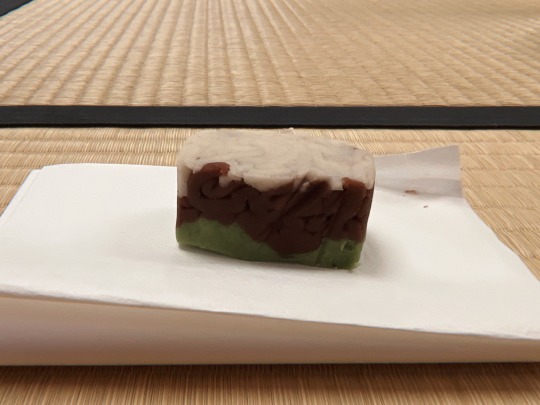
Today’s omogashi was called shitamoe which means below sprouts and refers to the greens coming out of the spoil below the snow.
#japan#tea#japanese culture#tea ceremony#matcha#omotesenke#the way of tea#茶道#抹茶#茶#お稽古#tea school#tealovers
3 notes
·
View notes
Text
|| big ole ooc
sup. I’m not gonna be posting for a bit. A friend died, I wanna focus on other stuff, other things too. I might like some things and I want to post the coloring once it’s done but besides that this, @unite-battle-network & @polteagueist are gonna be quiet.
Why this post is big? My friend (and me) was part of @/atypical-leaders now @monsion-no2. We agreed another person is gonna keep the blog since they were going to use one anyway and i get to post the info here. They said they’ll keep the posts but if that changes I’ll add them to this.
peace for now


The logo is an edit of pokémon revolution online. Don’t know why.
Here is the brief intros. Those who got ~more detailed bios have them linked by their name in the intros. I’ll write about the others here based on the notes. Meri & Archie don’t have much besides pkmn on the shared file so I’ll get them done first.
Meriwether’s challenge team was an excadrill (sandstorm), pelipper (rain), abomasnow (hail), walrein (rain), scovillain (sun & grassy surge). Love (mod) asked for help in psychic terrain but if there is anything on that I don’t have access. Meri was going to consider leaving the Leaders at some point
Archie has fossils for his team, dracovish & omastar & archaeops. Love was going to add paradoxes. He’s in a similar situation to Meri of leaving, kinda, he’s a minor leader (part time) so he didn’t hurt Bud by declining but also so he doesn’t have to be around them full time and he gets to do his job.
Daisy has a profile but since the character doesn’t type much Demi didn’t go into the team’s moves. Also since they aren’t fully done ig. I’m gonna straight ctrl c&v
Jyn = sweet kiss, lovely kiss, heart stamp, blizzard/avalanche.
Noct = hypnosis, dream eater, psycho shift, shadow ball
Forr = poison spikes?? I don’t know, Forres need more love but THIS IS WHY NO ONE ELSE LOVES YOU
Tox = toxic,
Chan = inferno, confuse ray, hex, dark pulse
Gimma used gimmicks like mega evos, gigant/dynamaxing, z moves, terrastilising. She is from Fiore, moved to Galar to do a trainer journey because their league is widely known and -maxing is unique to there & publicised and she wanted to experience it for herself. Learnt of other another region’s gimmick and went there and learnt of another and so on. Pokemon aren’t on there currently but Gimma was going to be another 4 pkmn challenge definitely including a swampert. She’s tied youngest with Sully, both 19. Demi & Min thought giving them a dynamic would be cool since she’s effectively a protag character while Sully is an evil team leader. How she would be able to -max idk. She has lots of bracelets. Demi’s really happy with her name.
Julienne used food ones. Challenge team was flapple, tsareena, slurpuff. Had 3 others in a vanilluxe (too injured), cherubi (too young), fidough (not interested in battling, tries play instead). Julienne owns a diner in Nimbasa. Name ideas include Pokébowl & Fraimon Diner & Frai Up. As mentioned by Other (mod), Julienne is intersex.
Hecate used ones that have different forms. They’re also all named after warhammer characters apparently. It’s team is Chakai the aegislash, Khorne the darmanitan, Tzeentch the ditto, Kairos the morpeko, Zuvassin the wishiwashi, and my personal favorite Nurgle the palafin. Hec was maybe gonna have a thing where it changes font. It’s generally cryptically verbose.
Sully was based on evil teams, kinda like how Team Yell work.? I haven’t played swsh. As opposed to the others who are all only leader battles, Sul has grunts who do general “look menacing and like your gonna cause trouble” things so trainers battle them, battling slightly stronger ones each time you beat the prior one until you get to him. His challenge is like a scavenger hunt I guess? Apparently the first batch of grunts give an option to join Team Evil and if trainers accept Sully is called to them to battle with his challenge team as they are when you fight him after beating his grunts. His team is Vierlence a hydreigon, Stiyx a clefable, a scizor, a nidoking, a milotic & an eelektross. He also has a service mon in Harma, a shiny spritzee that has healer ability & releases violent scent to encourage breathing, to help pulmonary fibrosis.
Buddy has an intro but I’d also had an idea to give them some traits that stemmed from their communal upbringing where they didn’t have a set parent, the people in the community center all cared for them when around. They ended up with a “people aren’t permanent in life, don’t get attached (but mons are fine because Jiji hasn’t left) but make the most of your time” philosophy which sometimes leads them to be overattached (right term?) and drive people away which reinforces the idea. This group of Atypical Leaders is their latest overattachment and others like Meri were possibly going to leave. As mentioned, Archie agreed to be part of the project to not hurt Buddy but on the condition of being minor so he could do other things.
2 notes
·
View notes
Text
Jamui: सिमराढाब गांव जंगल में दो ढिबरा तस्कर की हत्या, इलाक़े में सनसनी
Jamui: जमुई ज़िले के चकाई प्रखंड के अति नक्सल प्रभावित क्षेत्र बोंगी पंचायत के सिमराढाब गांव के जंगल में दो ढिबरा तस्कर की पत्थर से कूच कर हत्या कर देने का मामला सामने आया है. मृतक की पहचान चरका पत्थर थाना क्षेत्र अंतर्गत चरका पत्थर गांव निवासी नावा भुल्ला पिता नुनेश्वर भुल्ला एवं मकरकेन गांव निवासी रामकिशोर यादव पिता जेहल यादव के रूप में की गई है.
सोमवार की सुबह जंगल लकड़ी चुनने गए ग्रामीणों ने…

View On WordPress
#a highly naxal-affected area of Chakai block#BiharNews#Two Dhibra smugglers were stoned to death in the forest of Simradhab village of Bongi Panchayat
0 notes
Photo

Ingresso a una cerimonia del tè pubblica nella Sala Eishō-no-ma al Giardino Kōraku-en di Okayama. • Entrance to a Japanese tea party at Okayama Korakuen Garden’s Eishō-no-ma Hall. • 岡山後楽園栄���の間にある茶会の受付。 ••• #chakai #cerimoniadelte #culturadelte #nodate #architetturagiapponese #loto #nelumbo #stagno #riflesso #giardinogiapponese #teaceremony #japaneseteaceremony #teaparty #teaculture #japanesearchitecture #lotus #pond #reflection #japanesegarden #茶会 #野点 #茶文化 #日本建築 #蓮 #池 #反射 #日本庭園 #tè #tea #茶 (presso 岡山後楽園) https://www.instagram.com/p/Cdqd-rRhLkH/?igshid=NGJjMDIxMWI=
#chakai#cerimoniadelte#culturadelte#nodate#architetturagiapponese#loto#nelumbo#stagno#riflesso#giardinogiapponese#teaceremony#japaneseteaceremony#teaparty#teaculture#japanesearchitecture#lotus#pond#reflection#japanesegarden#茶会#野点#茶文化#日本建築#蓮#池#反射#日本庭園#tè#tea#茶
0 notes
Text
La Chakana
The Crux, commonly referred to as the Southern Cross, is the smallest and most definitive constellation of the Southern Hemisphere. A group of four main stars, the constellation may be used to find the cardinal points. Such importance is reflected in the multiple representation of the Crux, including the Australian, Brazilian, New Zealander, and Mercosur flags. This prominence is reflected in Andean culture, where the four points of the Crux are apparent in one of the region’s prevalent symbols, the Chakana.
Originating from chakay, meaning "to cross" in Quechua, the chakana is rooted in its astrological beginnings, but its significance is more extensive. Corresponding to Incan mythology, the cross incorporates the three Incan tiers: Uqhu Pacha, underworld of death, Kay Pacha, world of the living, and Hanan Pacha, celestial world of the gods. These tiers may also be redefined as: underground, earth, and sky; snake, puma, and condor among the sacred animals of the Inca; or village, Sapa Inca, and temple for dividing the Incan harvest.
The four arms of the chakana equate to the cardinal points, or may designate the four provinces of Tawantinsuyu, while the circle represents Qosqo and the circle of life. The twelve peripheral points mark the months in a year. The lines which run vertically through the symbol represent interconnectivity between the worlds while horizontal lines are the bonds which unite those within each world.
The frequency and popularity of the chakana in Andean art and society from antiquity to modern day is a testament to the symbol’s broad significance.


4 notes
·
View notes
Text
https://65fbfc66d36f6.site123.me/blog/chandan-singh-foundation-s-mission-of-free-education-and-marriage-support-in-bihar-chakai
Nestled in the heart of Bihar, amidst the tranquil landscapes of Chakai, a quiet revolution is underway. The Chandan Singh Foundation in Bihar , with its unwavering commitment to social empowerment and upliftment, is making waves through its transformative initiatives in the region. Foundation in Bihar.
#chandan singh foundation#chandan singh foundation in bihar#chandan singh foundation in chakai#foundation in bihar#chandansinghfoundationinchakai#chandansinghfoundationinbihar#chandansinghfoundation#foundationinbihar
0 notes
Text
Nampō Roku, Book 7 (80): Concerning Lord Hino’s¹ Use of Kayari [蚊遣]² in the Roji.

80) Concerning [his connection with] Rikyū-koji, Hino Terusuke had become his disciple, and [they] frequently visited [each other]³.
On an evening in the summer, [Terusuke] set up a kayari-bi [蚊遣火] in his garden, in the shade under the trees⁴. When [Ri]kyū saw this [he said] “indeed, isn’t that most tasteful!” -- he was deeply moved⁵.
Since then [it has become the practice that], in a secluded place in the roji [and] near the koshi-kake, in a suitable place in the shade under the trees, the kayari should be set to smoldering [in order to keep the area free of mosquitoes]⁶.
_________________________
◎ The toku-shu shahon version of this entry agrees with the Enkaku-ji manuscript. However, according to both Tanaka Senshō and Shibayama Fugen -- and rather curiously -- the genpon text substitutes the name of Lord Asukai [飛鳥井殿] (perhaps Asukai Masakata [飛鳥井雅賢; 1585 ~ 1626], who held the lower grade of the junior fourth rank, and was Sakon-e no shosho [左近衛少将], equivalent to lieutenant-general of the Sakon [Left] Guards unit) for that of Hino Terusuke [日野輝資; 1555 ~ 1623]. This is strange because, while Lord Hino is known to have been a disciple of Rikyū (he is mentioned several times in the Nampō Roku in this capacity), a connection between Rikyū and Lord Asukai is less well documented*.
___________
*In 1609, Asakai Masakata was exiled to Naka-no-shima [中之島] in Oki [隠岐] (a group of islands northwest of the border between Tottori and Shimane Prefectures) on account of having seduced one of the emperor’s ladies-in-waiting. Masakata died in exile later in 1626.
Masakata is not recorded to have had any interest in chanoyu, and there does not appear any other reason to associate Masakata with Rikyū.
The Asakai family was established during the Heian period, but they were always more closely associated with waka [和歌] and kemari [蹴鞠] than with other cultural activities. (Kemari, which appeared in something resembling its present form toward the end of the Heian period, is usually described as a kind of football; but the object of the game was to keep the ball in the air, and prevent it from touching the ground: after kicking the ball, that player had to intone an original waka before the ball was kicked again. As can be seen below, the participants usually wore casual court dress, as well as their lacquered caps of estate.)
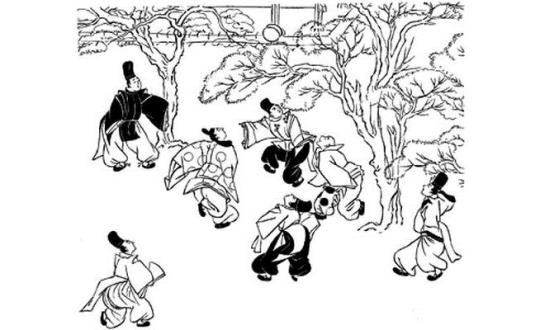
Members of the Asakai family were the instructors of kemari to the Ashikaga shōgun Yoshimasa and Yoshinao, and their courts. During the fifteenth century the Asakai also founded the Niraku school [二楽流] of calligraphy. Their fortunes seem to have declined in tandem with those of the Ashikaga house, so that they were remembered more for the scandal involving Masakata, than for other accomplishments during the sixteenth and seventeenth centuries.
¹Hino Terusuke [日野輝資; 1555 ~ 1623] was a scion of the hereditary court nobility (kuge [公卿]), who served in various governmental posts, ultimately being appointed Gon-dainagon [権大���言] (Supernumerary Grand Counselor of State) in 1597, at which time he was elevated to the senior grade of the Second Rank. He was thus the highest ranking among Rikyū's noble disciples.
Terusuke retired from government service in the Fifth Month of Keichō 12 [慶長十二年] (1607) and became nyūdō, taking the name Yuishin-in [唯心院]. Nevertheless, it seems that he remained a counselor to both Tokugawa Ieyasu and his son Hidetada until his death.
²Kayari [蚊遣] means mosquito repellent, and usually referred to burning pine-needles or dried mugwort (or an incense compounded from the latter) for this purpose. The practice had been employed at the Imperial Court since ancient times, but this occasion appears to have been the first time that it was used in the roji -- to rid the roji and koshi-kake of mosquitos during a chakai.
³Rikyū-koji ha, Hino Terusuke no montei ni natte, tsune ni mairare-keri [利休居士ハ、日野輝資ノ門弟ニ成テ、常ニ參ラレケリ].
Rikyū-koji ha [利休居士は] means concerning Rikyū-koji.
Koji [居士] was the “non-title” (meaning a Buddhist layman, or lay believer -- that is, a follower who had not formally taken the tonsure) that was bestowed on Rikyū in early 1586, so he could enter the Imperial Palace and assist* Hideyoshi’s service of tea to the Emperor Ōgimachi [正親町天皇; 1517 ~ 1593 -- his reign extended from the 27th day of the Tenth Month of Kōji 3 [弘治三年], 1557, to the 7th day of the Eleventh Month of Tenshō 14 [天正十四年], 1586] in Hideyoshi’s golden tearoom (which was set up on the deep veranda of one of the halls within the palace compound).
Hino Terusuke no montei ni natte [日野輝資の門弟になって]: this phrase is grammatically irregular; but the meaning seems to be that Hino Terusuke was one of Rikyū’s disciples†.
Tsune ni mairare-keri [常に參られけり] means that (he) frequently desired to visit‡ -- while this is usually understood to mean that Terusuke often visited Rikyū, the context of this entry implies that the visits between the two were reciprocal.
Here, and throughout the entire passage, he toku-shu shahon agrees exactly with the Enkaku-ji text**.
___________
*Despite occasional assertions to the contrary that are found in the popular tea histories, Rikyū’s job on this occasion was primarily to grind the tea, help prepare the utensils, and take care of various things that had to be done in the preparation area (such as emptying the koboshi, and returning it after cleaning, so Hideyoshi could replace it on the daisu), and sit in the vicinity of the sadō-guchi, ready to offer any advice that Hideyoshi might have needed. The surviving accounts suggest that the daisu-temae that Hideyoshi employed on this occasion used a bon-chaire and dai-temmoku, and everything used was either made of gold, or made of wood covered with gold (the temmoku was made in that way, since a gilded ceramic bowl would have been too heavy, and potentially could have been too hot to hold comfortably).
On this occasion, Rikyū did not meet the Emperor or serve him tea while Hideyoshi sat and chatted with the Emperor (the way some popular versions of the story suggest). Indeed, the Emperor would have been entirely unaware of Rikyū’s presence.
†Linguistically, the construction of this phrase seems to suggest that Rikyū became Lord Hino’s disciple, which is nonsense.
‡The suffix -keri [けり] might be interpreted to suggest that this was something that happened in the past, something that had already ceased to occur by the time that this text was written down.
And, indeed, as Lord Hino rose higher and higher in the government, he would have had correspondingly less time to indulge in things like chanoyu.
**As does the genpon text -- except that, as noted above, the genpon version inserts the name Asukai-dono [飛鳥井殿], Lord Asukai, in place of Hino Terusuke [日野輝資]: Rikyū-koji ha, Asukai-dono no montei ni natte, tsune ni mairare-keri [利休居士ハ、飛鳥井殿ノ門弟ニ成テ、常ニ參ラレケリ].
There does not seem to be any historical justification that might account for this change in the text, however, so it is difficult to imagine how the substitution came to be made by the editors of the genpon edition. Tanaka Senshō, however, argues that the reason for the name change was because of the Asakai family’s traditional connection with kemari (that was mentioned in the sub-note below my introduction). Because the Asakai were the national experts, the men of their family would have had to practice kemari out-of-doors throughout the year. During the summer months, because of the discomfort caused by mosquitoes (not only while playing, but also while resting between innings in the shade of the trees in the garden), they began to burn mosquito repellent in the garden to make their long practice sessions more endurable. Nevertheless, this does not give us any clues as to why Rikyū would have been visiting them, or why he would have been so deeply impressed by the idea of burning kayari in the garden.
⁴Natsu yū-gata, o-niwa no ko-kage ni kayari-bi wo tateraretari wo [夏ノ夕方、御庭ノ木陰ニ蚊遣火ヲタテラレタルヲ].
Natsu yū-gata [夏の夕方] means on an evening during the summer.
O-niwa [御庭]: the honorific o- [御] was probably used because Lord Hino was a member of the kuge [公卿], the hereditary court nobility, so the use of the polite form would indicate unambiguously that this garden was in his residence.
O-niwa no ko-kage ni kayari-bi wo tateraretari wo [御庭の木陰に蚊遣火を立てられたるを] means that in (Lord Hino’s) garden, in the shade of the trees*, a kayari-bi [蚊遣火]† was set up.
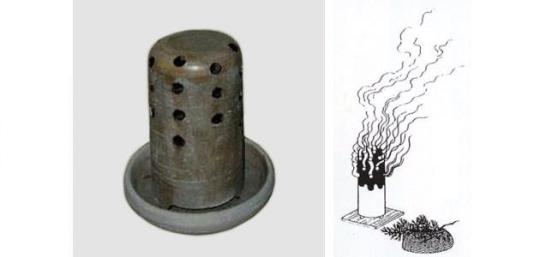
A kayari-bi was an openwork (usually ceramic) brazier (an Edo-period example of a kayari-bi that was made to be set on the floor of a room is shown above) in which either dried pine-needles, or stalks of dried mugwort (Artemisia princeps, and possibly other species)‡, were set to smoldering, since the smoke from these plants had mosquito-repelling properties.
However, by the point in the Edo period when this text was written, mosquito-repellent incense sticks (katori-senkō [蚊取線香]**), made from crushed mugwort mixed with charcoal powder, also seem to have been invented, so this entry could be referring to either form of kayari.
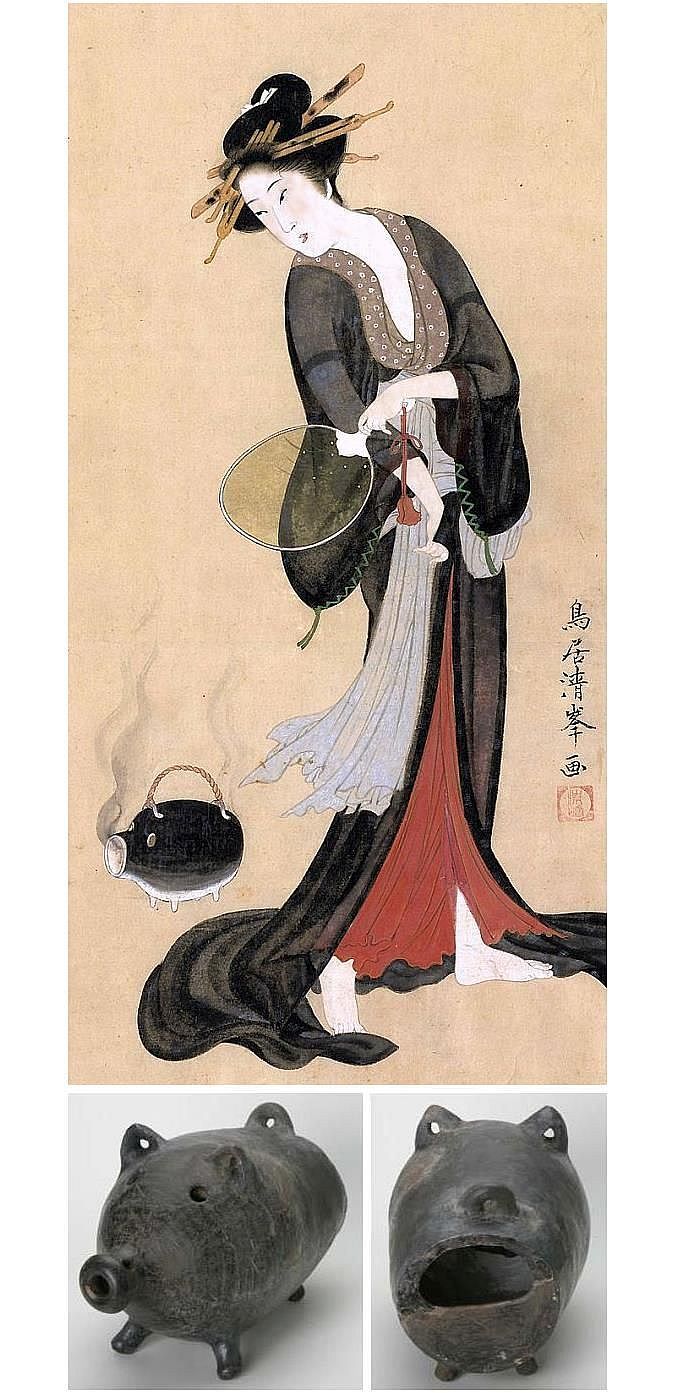
The above painting, titled Kayari-bijin [蚊遣美人] (“a Beauty with a kayari-bi”), by Torii Kiyomine [鳥居清峯; 1836 ~ 1867] shows how a handle was attached to another Edo-period example of a katori-bi (an antique example is shown below the painting -- the pine-needles, stalks of mugwort, or a coil of mosquito incense, would be placed inside through the large hole in the back side of the kayari-bi). The handle was used to carry the kayari-bi from place to place, as needed, to keep the mosquitos away††.
__________
*Since the gathering during which this kayari-bi was set up in the roji was held in the evening, the shade from the trees is probably less important to the story than the fact that the kayari-bi was placed somewhere where it would not be seen. The purpose was, of course, to chase away the mosquitoes and other night insects from the vicinity of the koshi-kake and roji.
†With respect to this use of a kayari-bi in the roji, Tanaka Senshō comments:
Kayari de naku, eji-kago tote, niwa no tsūro ni kō wo taku-koto ha ko-rai aru. Ka no dō no tsuru ya, kamo nado wo tei-jō ni oite kō wo taku-koto ha, ko-rai okonawareta-koto de aru. Kono-koto kara, kayari wo omoi-tsuita no de arau ka. Roji ni kayari wo tateta-koto ha, mukashi to shite omoshiroi shu-mi de aru. Ima-doki ha, ryōri-ya no teien ni, katori-senkō ga takarete-iru ga, kore ha fūryū to ha ienu. Yahari, eji-kago nado suete, mukashi-fū no kayari-bi no kata ga omoshiroi to omou
[蚊遣でなく、衛士籠とて、庭の通路に香を炷く事は古来ある。彼の銅の鶴や、鴨抔を庭上に置いて香を炷く事は、古来行われた事である。此事から、蚊遣を思ひ付いたのであらうか。露地に蚊遣を立てた事は、昔として面白い趣味である。今時は、料理屋の庭園に、蚊取線香が炷かれているが、是は風流とは云ヘぬ。やはり、衛士籠抔据ゑて、昔風の蚊遣り火の方が面白いと思ふ].
“In the absence of a kayari, since ancient times it has been the practice that even [something like] an eji-kago [衛士籠] might be set up beside the garden path and used for burning incense. As for placing bronze cranes and ducks and the like in the garden for burning incense [to perfume the air], this has been done since ancient times. Perhaps this was how they came up with the idea of [burning] kayari? Setting up the kayari in the roji must have been a interesting way to amuse [oneself] in bygone days. Nowadays, katori-senkō is burned in the gardens of restaurants, but [I don’t] think this can be called tasteful. I think it would be much more interesting to set up an eji-kago and make use of this old-fashioned way of repelling mosquitos!”
An eji-kago [衛士籠] (the name means a sentry’s/gatekeeper’s basket -- by the light of which the guard was able to identify people approaching the gate for admittance) was (originally) an iron basket, suspended from or on some sort of stand or tripod (as can be seen below), in which wood was kindled for illumination. This arrangement was also referred to as a kagari-bi [篝火] -- as in the following Edo period illustration for chapter 54 of the Genji monogatari [源氏物語] (which sets the scene on a veranda whose garden is illuminated in this way). In the picture we see a line of kagari-bi (often translated as “flares”) set up along the bank of the garden stream, with the fires attended by underlings.
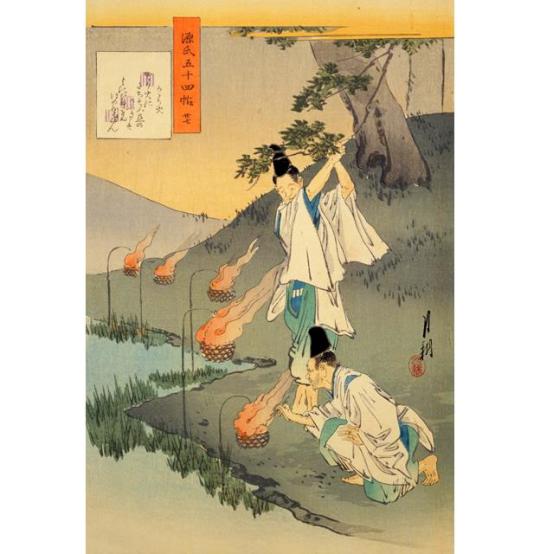
Here, it is unclear whether Tanaka believed that the smoke from the fire in the kagari-bi would be sufficient to drive the mosquitoes away, or whether he is using the word eji-kago to refer to a similar sort of arrangement -- albeit one in which pine needles or mugwort, or some other special material, would be burned in similar manner to produce the desired fumigatory or mosquito-repelling effect.
The reference that he makes to bronze cranes and ducks installed in the garden is either addressing the matter of the supports from which the containers of smoldering incense (usually crushed jin-kō [沈香] or kyara [伽羅], or blends based on these) were suspended (the bowls were taken in when incense was not being burned, leaving the bronze statues standing in the garden as decorative objects in their own right), or to bronze censors cast in these shapes (such as the one shown below) that were set out in the garden to perfume the air.
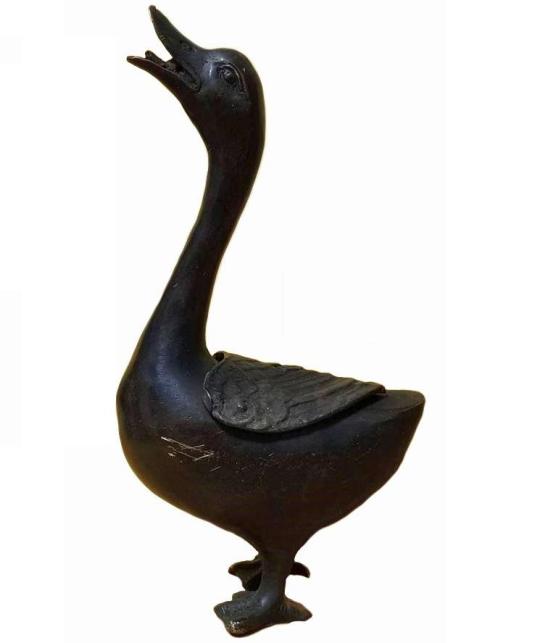
It might be added that most of the oldest tsuri-bune [釣り船] imported from Mogul India and China were originally made as hanging incense burners.
‡This plant is called yomogi [よもぎ = 蓬) in Japanese, and ssuk [쑥] in Korea. In addition to its mosquito-repellent qualities (in Korea, the plant was traditionally cultivated along the edge of the veranda, since even when living the essential oils volatilize into the air, deterring mosquitos; and in the autumn the stalks were cut down to the ground, and then suspended upside-down under the eves to dry for use as a kayari (fumigant) the next year). Mugwort is also used in both country’s cuisine; in Korea, it is also used in certain varieties of traditional sweets (though strongly-flavored sweets of this kind fell out of favor in Japan early in the 20th century -- when the preference shifted to tastes that would best appeal to young women). Mugwort is also used in the traditional medicine of both countries (and the mugwort-flavored sweets were just one example).
**While originally produced as straight incense sticks, the coil version of katori-senkō seems to have appeared during the Edo period as well -- allowing for a longer-burning piece of incense that was not spatially limited as a linear stick would have been.
††The fact that the roji is watered so frequently means that mosquitoes are an inevitable menace from late spring to deep autumn, where they usually attack the participants at the exposed strip of skin between the edge of the tabi and the hem of one’s kimono -- a sensitive area where their bite is horribly annoying (especially in Japan, where the custom is to avoid touching the feet and ankles as much as possible, so the brief relief of scratching is completely out of the question).
⁵Kyū mite, sasuga ni fūryū-no-koto kana to kanshin-shi [休見テ、サスガニ風流ノコトかナト感心シ].
Kyū mite [休見て] means (and) when Rikyū saw this...
Sasuga ni fūryū* no koto kana [流石に風流のことかな] means “indeed, isn’t that most tasteful!” These words were supposed to have been murmured by Rikyū when he noticed the faint tendrils of smoke trailing through the plantings†.
To kanshin-shi [と感心し] means as he was deeply moved (by the sight).
___________
*The expression fūryū [風流], especially as it is being used here, did not enter the lexicon of the chajin until the Edo period (indeed, fūryū was, culturally, a very important and popular way of describing moving, tasteful, and “artistic” experiences from the second half of the seventeenth century onward). This helps us understand that this text, while possibly based on a real incident -- the first time that a kayari-bi was used during a tea gathering to keep the roji and koshi-kake free of insects during night gatherings in the summer -- could not have been written until the late seventeenth century.
†Perhaps it initially reminded him of the smoke of the burning pine needles that trailed through the pine trees during the fusube-chanoyu [ 燻べ 茶の湯] that Rikyū had created for Hideyoshi as a way to enjoy chanoyu even in the pine barrens at Daizen-ji and Hakozaki, during the Kyūshū campaign of 1586~7.
See the post entitled Nampō Roku, Book 7 (66): Fusube-chanoyu [フスベ茶湯] – a Tea Gathering Held Out-of-doors for further details. The URL is:
https://chanoyu-to-wa.tumblr.com/post/726511147567775744/namp%C5%8D-roku-book-7-66-fusube-chanoyu-%E3%83%95%E3%82%B9%E3%83%99%E8%8C%B6%E6%B9%AF
⁶Sono ato, roji・koshikake no atari, ko-kage no shikaru-beki-tokoro ni, kayari wo takare-shi-koto ari [其後、露地・腰カケノアタリ、木陰ノシカルベキ所ニ、カヤリヲタカレシコトアリ].
Sono ato [その後] means after that, later on, afterward.
The implication is that this gathering, hosted by Hino Terusuke, was the first occasion on which a kayari-bi had been used, secreted under the trees to clear the area of noxious insects during the chakai. The realization of how useful this would be is why Rikyū is made to be so impressed and moved -- because he had never though of doing something like that himself*.
Roji・koshikake no atari [露地腰掛の當り] means in an out-of-the-way place in the roji and koshi-kake; on the edge of the roji and koshi-kake.
Ko-kage no shikaru-beki-tokoro ni [木陰の然るべき所に]: ko-kage [木陰], as above, means in the shade of the trees (in other words, in an inobvious place under the trees that were planted to obscure the fences that enclose the roji from view); shikaru-beki-tokoro ni [然るべき所に] means in a suitable place, in the right place.
Kayari wo takare-shi-koto ari [蚊遣を薫かれしことあり] means the fumigant† should be set to smoldering‡ (in the shade under the trees).
__________
*It appears that the burning of kayari originated with, and was largely restricted to, the Imperial Court -- with kayari-bi set up in obscure corners of the various ceremonial and audience halls, to eliminate mosquitoes that would have disrupted the proceedings (since mosquitoes remain active even during the daytime in such large, and dark, spaces, and court ceremonials and audiences could carry on for hours without a break).
†Kayari [蚊遣] -- without the -bi [火] -- means a fumigant or mosquito repellent; however, this short form was also used informally as a way to refer to the kayari-bi, as a self-contained unit, so either interpretation would be correct.
‡This particular verb, takareru [薫かれる], is used specifically to mean to “burn” something like incense -- not with an active flame, but so that it smolders slowly.
==============================================
◎ If these translations are valuable to you, please consider donating to support this work. Donations from the readers are the only source of income for the translator. Please use the following link:
https://PayPal.Me/chanoyutowa
2 notes
·
View notes